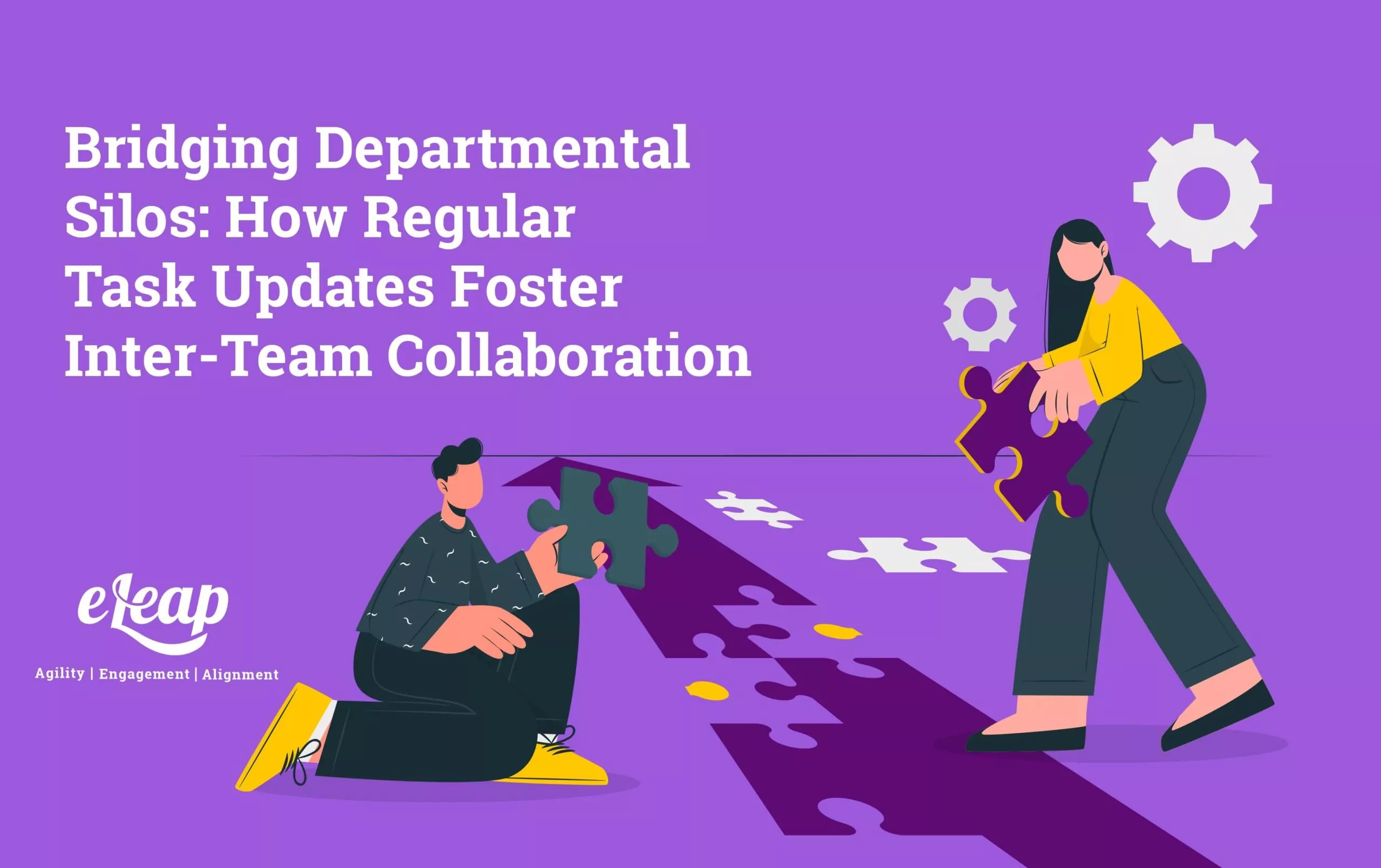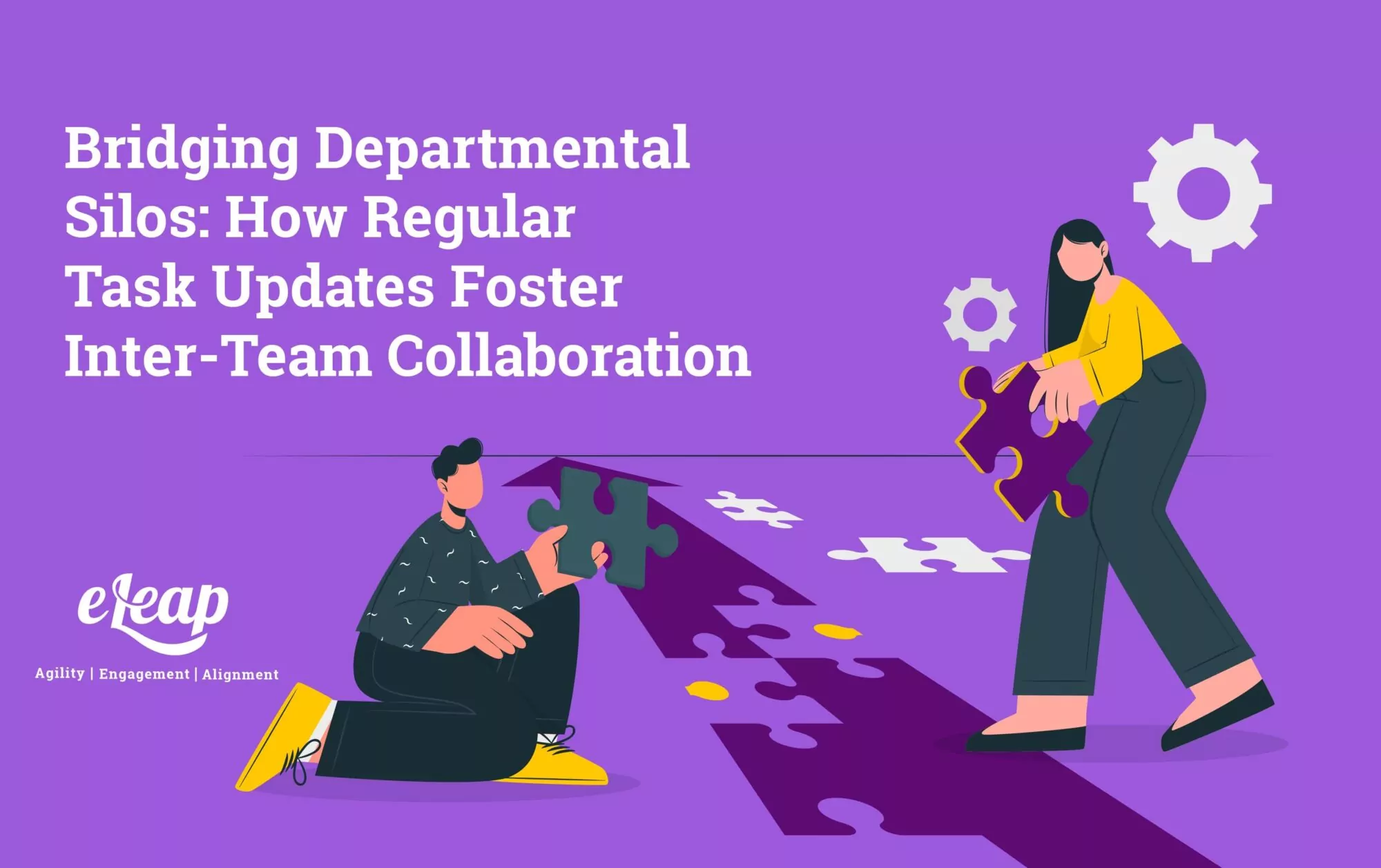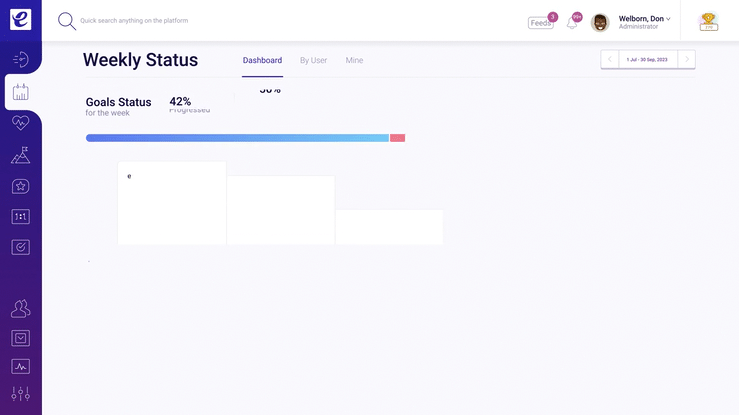Bridging Departmental Silos: How Regular Task Updates Foster Inter-Team Collaboration

At the Alpha Corp office collaboration system, as the sun cast a gentle glow across the lounge, Sarah was eager to share something with Mike. “Mike, take a look at this infographic I’ve been burning the midnight oil on for our product launch,” she said, beaming with pride. Explore how eLeaP®’s Performance Management Platform can simplify evaluations, boost productivity, and drive measurable results.

Mike, however, was taken aback. “Sarah, you won’t believe it,” he responded, revealing a design on his laptop strikingly reminiscent of Sarah’s. “I’ve been on a similar track!”
Their designs, while distinct in style, covered the same content. The realization that they’d inadvertently duplicated efforts was a blow.
Such overlaps are an all-too-common hiccup in many organizations. Despite everyone’s best intentions, without a platform for open communication, teams might continue working in silos, and efforts can crisscross without anyone realizing.
But what if there was a way out of this maze? How do teams ensure they’re not just chasing tasks but also genuinely understanding the passions powering those projects? What if everyone could have a clear picture of the challenges their peers are tackling and the milestones they’re achieving?
Imagine a situation where teams seamlessly merge their expertise, eliminating silos. That’s where the Weekly Status Task & Collaboration System shines. It ensures teams aren’t merely sharing a workspace but actively weaving their skills together. As you continue reading, you’ll uncover how this system holds the potential to reinvent collaboration within your organization.
Why Embrace the Regular Task Updates & Collaboration System?
Regular task updates, primarily through systems like the Weekly Status Task & Collaboration System, are game-changers for modern organizations. Here’s why they’re indispensable:
- Reduction in Redundancies: By having a clear picture of the tasks and projects other teams are focused on, departments can avoid duplicating efforts. This not only saves time and resources but also streamlines operations, making them more efficient.
- Improved Resource Allocation: With regular updates, managers and team leads can identify where additional resources might be required or where they might be underutilized. This real-time data aids in the effective allocation of resources, ensuring teams have what they need to succeed.
- Facilitates Quick Decision-Making: With real-time or weekly updates on projects and tasks, decision-makers can act promptly. Delays are minimized, and teams can pivot quickly based on the most recent information.
- Encourages Accountability: Knowing they’ll provide regular updates encourages team members to remain accountable for their tasks. This gentle yet consistent reminder that teams will share their progress can boost motivation and productivity.
- Strengthens Inter-Team Collaboration: When teams are aware of what others are doing, it opens the door for collaborative efforts. A marketing team, for example, can work closely with the product team if they know a new product feature is about to launch. Or, the customer support team can provide feedback to the tech team based on customer interactions.
- Boosts Morale and Engagement: Regular acknowledgment of team efforts and accomplishments can boost morale. When teams know their hard work is being recognized and appreciated, it enhances their engagement levels. Also, teams feel valued, knowing that their contributions and challenges are recognized and understood by others. This mutual understanding often leads to collaborations, with departments pooling their expertise to tackle challenges or seize opportunities.
In summary, regular task updates like the Weekly Status Task & Collaboration System act as the lifeblood of an organization, nourishing every department and ensuring they work harmoniously towards shared objectives.
How to Get the Best of Regular Task Updates & Collaboration System
Maximizing the benefits of the Regular Task Updates & Collaboration System entails more than just understanding its features. It’s about meshing insightful planning with tangible application. Delving into this tool shows that true optimization transcends its basic use. Instead, it requires deep dedication, careful planning, and a relentless pursuit of cultivating collaborative bonds. So, let’s journey together through a detailed exploration of how to maximize its effectiveness and weave it seamlessly into the fabric of an organization’s daily operations.
1. Clear Objectives
Harnessing the full potential of the Regular Task Updates and collaboration System starts with clarity. Understanding your objectives is crucial, as it steers how the system is utilized and how teams interact within it:
- Define the Desired Outcome: Before settling for the system, ascertain your goal. Do you want to curtail repetitive tasks, fine-tune how resources are distributed, or amplify the synergy among team members? Pinpointing these objectives from the onset ensures the system is aligned with these goals.
- Set Clear Expectations for Teams: Once the organizational objectives are defined, translate them into actionable goals for individual teams. Are they expected to provide daily task insights, weekly project progress, or occasional feedback? By clarifying this, you’re providing teams with a lucid understanding of what’s expected, ensuring that their updates on the platform are both relevant and insightful.
- Guiding Beacon: Consider the objectives as the north star for your teams. By giving them a clear goalpost, you not only guide their interactions within the system but also offer a consistent reference point. This helps them discern the kind of updates and collaborations that would be most beneficial, ensuring that their contributions are in tandem with organizational aspirations.
2. Training and Onboarding:
Any system is only as good as its users. Properly training team members on collaboration tools ensures they’re utilized to their fullest potential. To achieve this, you should provide:
- Regular Workshops: Offer workshops that detail the features and best practices of the collaboration tool. If there are new updates, explain their essence and applications to team members.
- Feedback-driven Learning: Post-training, collect feedback to identify areas where further instruction might be needed.
By focusing on these essential elements, teams can quickly grasp the system’s capabilities and integrate it effectively into their workflow.
3. Transparent Communication
Transparent communication is the bedrock of effective collaboration. But it’s not enough to merely exchange messages. Transparency implies:
- Openness: Everyone, from junior employees to leadership, should feel comfortable sharing insights, challenges, and ideas without fearing backlash or judgment.
- Honesty: The collaboration system is a platform to not only highlight the triumphs but also discuss the hurdles. An honest portrayal of ups and downs paves the way for collective problem-solving and growth.
- Regular Touchpoints: Host frequent meetings, perhaps weekly or bi-weekly, where teams provide task updates and the reasoning behind their decisions. This cultivates a culture where everyone is continually aligned.
Netflix, for instance, has been a standard-bearer in transparent communication. Their culture memo, made public, emphasizes how well they value transparent communication. By championing principles like “communicating candidly and directly” and ensuring information is “shared openly, broadly, and deliberately,” Netflix has breathed life into its team philosophy: “You make time to help colleagues across Netflix succeed.” It’s clear that their commitment to transparency has solidified their reputation as industry pioneers.
Another compelling example of transparent collaboration can be seen at Spotify. Beyond being a music streaming behemoth, Spotify is recognized for its innovative team organization, coined the ‘Squad System.’ This system comprises teams (or “squads”) that operate independently yet remain aligned with the overarching company goals. To ensure a cohesive approach, they introduced ‘guilds’— cross-functional communities where members exchange insights on specific areas. This structure ensures that a developer in Stockholm is well aware of the projects undertaken by her counterpart in New York, eliminating redundancies. Their transparent framework doesn’t just streamline their operations; it embraces a culture where every team member believes their input is invaluable.
4. Integration with Existing Tools:
Organizations often juggle multiple platforms to enhance productivity and streamline workflows. The Regular Task Updates & Collaboration System, to maximize its efficacy, should ideally dovetail with these existing tools:
- Communication Platforms: If your team is already accustomed to platforms like Slack for instant messaging or Microsoft Teams for meetings, ensure the collaboration system interfaces seamlessly with them. This allows for automatic updates or notifications, enhancing the flow of information and preventing any communication bottlenecks.
- Project Management Software: Tools like Trello, Asana, or Monday.com often serve as the backbone for task tracking and project timelines. By integrating the Collaboration System with these, teams can synchronize their updates, maintain real-time task progress, and have a unified view of project status.
This integration eliminates the stress of inputting the same data on multiple platforms. Everything gets updated centrally, ensuring that everyone stays on the same page without the hassle of manual cross-posting. Also, teams are more inclined to embrace the Collaboration System when it fits naturally into their existing work ecosystem, minimizing the learning curve and accelerating its uptake.

5. Feedback is Gold:
Sharing updates goes beyond just passing along information; it’s about nurturing a space where everyone continuously learns and evolves. Feedback, in such a setting, isn’t just helpful—it’s essential. So, when your team takes the initiative to share their updates through the collaboration system, it’s essential to meet them halfway with timely and constructive feedback. Celebrate their achievements, and if someone’s struggling, offer support. Ignoring these updates may lead to dwindling enthusiasm for using the system.
Let’s explore how you can maximize it.
- Bilateral Communication: Feedback should never be a one-way street. While managers and team leaders provide insights on team updates on the platform, it’s equally essential for team members to voice their perspectives, challenges, and suggestions when required.
- Constructive Over Critical: When providing feedback to a team update on the system, the emphasis should always be on constructive feedback. Instead of merely pointing out what went wrong, the focus should be on how to make it right. This approach ensures that the feedback process is seen as a tool for growth, not as a means of criticism.
- Action on Feedback: One of the fastest ways to render the feedback process ineffective is to ignore the feedback given. Encourage team members to always act on the feedback received, especially when it highlights areas for improvement.
By following these detailed guidelines and integrating them into daily operations, organizations can transform their approach to task updates and collaboration. This holistic approach enhances efficiency and embraces a culture where every team member feels valued, understood, and aligned with the organization’s vision.
Conclusion
Connecting departmental silos stands as a pivotal challenge and opportunity for organizations. Through the real-life account of Sarah and Mike, we’re reminded of the pitfalls that await in the absence of clear communication and collaboration. The Weekly Status, Task & Collaboration System revolutionizes how we approach transparency, embracing mutual respect and turbocharging efficiency. By cultivating a culture where every team member’s progress, challenges, and victories are on display, organizations can amplify a sense of unity and purpose.
Understanding, supporting, and growing together becomes the new norm rather than an exception. The magic happens when companies realize that the combined strength of their teams, when given the right platform and encouragement, can create wonders. Such a cohesive approach not only prevents overlapping efforts, like Sarah and Mike’s, but also propels organizations towards achieving shared objectives with enthusiasm. By breaking down the barriers and celebrating collective genius, companies can chart a course to unprecedented success.
Elevating Organizational Growth with eLeaP
Established in 2002, eLeaP has evolved into a comprehensive suite encompassing a cloud-hosted Learning Management System (LMS) and Performance Management Platform (PMP). These robust tools are crafted to help organizations elevate engagement, enhance performance, and ensure skills and compliance are consistently honed and up-to-date.
With honors like the Capterra Award and recognition for being one of the Top 10 LMS Website Designs in the eLearning Industry, eLeaP has proven its commitment to excellence. Our Weekly Status, Task & Collaboration System is a standout, offering an intuitive approach for leaders to monitor employee progress and foster a culture of success and continuous improvement. It’s this blend of innovation and practicality that makes eLeaP a cornerstone for organizations focused on growth and learning.